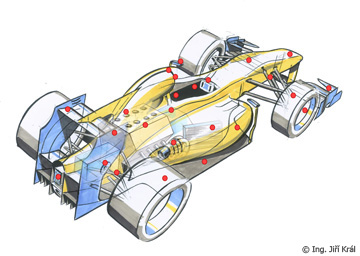The Bahrain GP according to Brembo An in-depth look at Formula 1 brake use on the Sakhir circuit
Alessandra Fedeli/ Brembo | 1.4.16 | Brembo F1 brzdy
Brembo F1 2016
The Bahrain GP according to BremboAn in-depth look at Formula 1 brake use on the Sakhir circuitThe Bahrain International Circuit will host the 2nd race on the 2016 Formula 1 World Championshipcalendar from 1 to 3 April.
The Middle Eastern circuit is a very tough test bench for all of the braking system components. Infact, the track pertains to the group of six World Championship races that put the most stress on thebraking system. Designed by Hermann Tilke, the track is located in a desert area about a dozenkilometres from the capital, Manama. Even though the competition is held at night, the temperaturesare extreme: last year, during the race, the temperature of the asphalt never fell below 28.8 degrees.This increases mechanical grip and makes thermal exchange difficult during the braking process.This aspect, together with an abundance of high energy stopping and braking sections at shortdistances from each other, leads to greater wear of the friction material: the biggest danger to beavoided if one wants to finish the Grand Prix.
According to Brembo technicians, who classified the 21 World Championship tracks on a scale of 1to 10, the Bahrain International Circuit falls into the category of the most challenging circuits forbrakes. The Bahrain track earned a score of 9 on the difficulty index, identical to recently built trackslike Singapore and Baku, which has yet to be used.
Brake use during the GP
The time spent braking, 20% of the overall duration of the race, is slightly higher than average forthe championship. The average deceleration, equivalent to 4.1 g, is decidedly higher than othertracks and lower than very few other championship circuits. As for the energy dissipated in stops,the Bahrain International Circuit falls at about halfway among the circuits that are fairly "energyvoracious": on average, during the whole Bahrain GP, the amount of energy dissipated by a vehicleduring the braking process is equivalent to about 131 kWh, which is very similar to the figure for bothAustin and Sochi. Furthermore, throughout the race each driver has to brake approximately 450times, applying a total force on the pedal that surpasses 56 tonnes. And while this figure is significant,the Australian GP registered 64 tonnes for the same value.
The most challenging braking zones
Of the 8 braking zones at the Bahrain International Circuit, half are classified as difficult on thebrakes, while the other four are of medium difficulty.The four most challenging braking sections, those with a deceleration greater than 4.4 g, areconfronted by vehicles travelling at 300 km/h or just slightly less. The one feared the most is theSchumacher curve (turn 1) because the drivers arrive at a speeds that reach 330 km/h and theyhave to face a 5.2 g deceleration: the braking force required is greater than 2,200 Kw, but moreimportant is the brake time (1.76 seconds), which is one of the highest in the entire WorldChampionship.The four braking sections that have a medium level of difficulty on the brakes are all positioned inthe central part of the track and are broken up only by curve 11, where a load of 143 kilos is appliedto the pedal.
Brembo Victories
In Bahrain, Brembo has won 9 out of 11 races competed in up to today, including the last eight. Theteam that has won most often at Sakhir with Brembo brakes is Ferrari. Six drivers have won at leastonce with Brembo brakes and five of these are still active: the most important names missing on therole call are Rosberg and Raikkonen. Is it their turn now?




